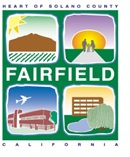| | | | | | | | 
AGENDA REPORT
|
| | | | | | | | DATE:
| October 20, 2020
| TO:
| Mayor and City Council
| FROM:
| Stefan T. Chatwin, City Manager 
| | SUBJECT: | Public Hearing;
and Resolution 2020-205 of the City Council of the City of Fairfield Adopting the City of Fairfield Senate Bill 743 Implementation Procedures which Includes Thresholds of Significance and Mitigation Measures for Vehicle Miles Traveled (VMT) as Required by the California Environmental Quality Act (CEQA) Guidelines Implementing SB743 Addressing Environmental Review of Transportation Impacts Under the California Environmental Quality Act (CEQA) |
|
| | | | | | | | | RECOMMENDED ACTION | | Hold public hearing and adopt resolution. |
|
| | | | | | | | | STATEMENT OF ISSUE | A project’s impact on transportation is one of the key environmental topics reviewed by the City under the California Environmental Quality Act (CEQA). When the City determines that a project may have “significant impacts,” the City may require mitigation measures such as changes in project scope and scale, new or modified traffic signals, construction of new turning lanes, or even investment in alternative transportation infrastructure.
As of July 1, 2020, changes in State law and the State CEQA Guidelines mandate a change in how lead agencies review transportation impacts under CEQA. Staff have prepared a recommended strategy to address these changes, incorporating new thresholds of significance, analysis methodologies, criteria for screening projects from further review, and mitigation strategies.
|
|
| | | | | | | | | DISCUSSION | CEQA requires a lead agency to review the impacts a project would have on the existing environment, to disclose those impacts to the public and decision makers, and to address those impacts that are deemed “significant”. CEQA defines a “significant impact” as a “substantial, or potentially substantial, adverse change in the environment,” and places potential impacts in four categories: (1) no impact; (2) less than significant impact; (3) less than significant impact with the adoption of mitigation measures; and (4) significant and unavoidable impact. A “threshold of significance” for a given environmental impact defines the level of effect above which the lead agency will consider impacts to be significant, and below which it will consider impacts to be less than significant.
The City of Fairfield General Plan establishes a threshold of significance for transportation impacts based on measured delay (Level of Service “A” through “F”) on roadways impacted by proposed projects. In Fairfield, the level of service (“LOS”) threshold of significance for purposes of CEQA is “D” for arterial streets during peak afternoon commute periods (PM peak hour) which represented some delay but not gridlock, “C” for collector streets, and “B” for local streets.
The State enacted Senate Bill 743 (SB 743) in 2013 with the goal of balancing the needs of congestion management with statewide goals related to infill development, promotion of public health through active transportation, and reduction of greenhouse gas emissions (GHG). To accomplish these goals, the legislation directed the Governor’s Office of Planning and Research (OPR) to develop different metrics for identifying effects on transportation under CEQA. The final OPR Technical Advisory was released in December of 2018 and identified “vehicle miles traveled” (VMT) per day as the most appropriate measure of transportation impacts for land use projects, land use plans, and transportation projects. The Natural Resources Agency also updated the State’s CEQA Guidelines to require lead agencies to use VMT and prohibit the use of LOS or vehicle delay as a criterion for transportation impacts under CEQA. However, Fairfield can continue to review LOS impacts for their consistency with the adopted General Plan standard.
VMT is a measure of the number of trips and total distance in miles that a driver would have to travel between their origin and destination. In general, projects that are farther away from other land uses or that lack nearby transit options tend to generate higher VMT, while projects located closer to a variety of land uses or near high quality transit generate lower VMT. Whereas LOS was a measure of the delay experienced by users of the transportation infrastructure, VMT measures the transportation efficiency of the proposed project with respect to the actual vehicle trips generated by the project.
Applying VMT as the measure of transportation impact will help create or encourage better more walkable neighborhoods that have access to everyday needs. The infill and transit-oriented development supported by VMT analysis can potentially help reduce overall vehicle use, reduce energy consumption, help preserve natural and agricultural lands, and reduce water consumption through more compact land use planning. Further, lower VMT is associated with additional benefits such as placemaking (creation of quality public spaces), reduction in other air pollutant emissions and water pollution, long term reduction in traffic congestion, and improvements in safety and public health, among others.
The CEQA Guidelines required lead agencies to begin using the new VMT metric on July 1, 2020. This implementation can occur on a project-by-project basis, but it is more streamlined and effective when adopted as a local threshold of significance. The VMT process requires a significant change in how the City reviews development projects. The City retained DKS Associates to assist the City with developing this new approach for environmental review under SB743. As part of their scope, DKS Associates prepared a series of Technical Memorandums during their SB743 work for the City. The final document, Fairfield Senate Bill 743 Implementation Procedures (“Implementation Procedures”), summarizes the consultants’ recommendations for implementing CEQA review under SB743. The Procedures manual contains several components, including:
- Thresholds for Significance.
Based on State guidance, the consultant and staff are recommending that the threshold of significance be set at 85% of the current calculated baseline VMT per land use unit, as calculated over the Fairfield traffic model area (15% below current calculated VMT levels). The typical VMT rates for various land uses are summarized in Table 1 in the Implementation Procedures.
- Criteria for Screening Projects.
Not all projects will require further analysis, and the Implementing Procedures includes screening criteria such as project size, type of project, and location. For example, a smaller project like an infill subdivision with fewer than 11 units can be presumed to have no significant VMT impacts (Table 3 in the Implementation Procedures). For other land uses, the State guidelines use net increase in VMT as the criteria. In practice, it means local-serving retail (typically less than 50,000 square feet) and smaller scale medical office uses can be screened from further environmental review. Other project types that State guidelines will allow the City to screen from further review include low-income housing and housing within ½ mile of a major transit facility. In Fairfield, this would include some properties in the Train Station Specific Plan Area as well as much of downtown Fairfield. The guidelines also allow the City to screen from further review transportation and infrastructure projects unlikely to generate significant net VMT, such as maintenance and rehabilitation projects, road diets, and pedestrian, bicycle, or transit improvements.
Finally, the recommended Implementation Procedures allows the City to take into account those areas in Fairfield where existing VMT levels fall below the 85% threshold. The rationale here is that the area likely already has a good mix of uses and adding additional uses in this area provides for less and/or shorter trips and bundling of trips. State guidelines will allow the City to exempt from further VMT analysis many infill sites in Central Fairfield, as illustrated on the maps in the Implementation Procedures.
- Analysis and Mitigation
Not all projects will be screened from further review. For projects in areas identified as “above” the 85% threshold or that do not meet the size or land use screening criteria, further analysis will be required. Project consultants will be required to use the City’s traffic model to analyze VMT generation rates for their project.
Many of these projects will exceed the threshold of significance, meaning that the project may have a significant effect on the environment. As with all CEQA impacts, significant transportation impacts will require mitigation. The State guidelines published by OPR in response to SB743 establish criteria for mitigation measures (Table 4 in the Implementation Procedures), which include:
- Increasing project density
- Mixed use development (“Diversity of development”)
- Incorporating affordable housing
- Project design (to reduce trips and trip length)
- Pedestrian network improvements+
- Parking demand management
Where impacts cannot be mitigated to a less-than-significant level (or if a project has other types of significant environmental impacts), CEQA may require preparation of an Environmental Impact Report and a Statement of Overriding Considerations.
Notably, the forthcoming General Plan Update represents an opportunity to fully integrate the VMT concept and larger scale mitigation measures into the City’s development framework. Some of these larger scale strategies have already been proposed for the Train Station Specific Plan, and the City will be working with developers in that area to recognize the inherent VMT reduction strategies in the Plan for their projects. A similar approach to planning would be appropriate for the City’s General Plan Update.
Environmental Review
Adoption of a new local CEQA threshold of significance for VMT impacts and the adoption of the Fairfield Senate Bill 743 Implementation Procedures will not have a significant environmental impact and is exempt from CEQA review under Section 15308 of the CEQA Guidelines. The actions are being undertaken to comply with a State mandate (SB 743) and will be used in a regulatory process (CEQA review) that involves procedures for the protection of the natural environment.
|
|
| | | | | | | | | FINANCIAL IMPACT | | There are limited direct financial impacts to the City. The City may choose to retain consultants to assist with project review for VMT impacts. Applicants will continue to pay planning fees for environmental review, and applicants may need to bear the cost of VMT analysis as part of their application. |
|
| | | | | | | | | CITY COUNCIL WORKPLAN | Community Safety
| Community Infrastructure | Quality of Life | | Financial and Operational Sustainability | Economic Development | Travis Air Force Base |
| City Council Goal this item supports:
Community Infrastructure, Quality of Life |
|
| | | | | | | | | Project: | One-time item not recommended for including in the Workplan
|
|
| | | | | | | | | PUBLIC CONTACT/ADVISORY BODY RECOMMENDATION | At its September 23, 2020 meeting, the Planning Commission held a public hearing that was duly noticed in the Daily Republic on September 13, 2020. At said meeting, the Planning Commission adopted Resolution No. 2020-15 recommending Council adopt a resolution establishing VMT thresholds and criteria for environmental review.
|
|
| | | | | | | | | ALTERNATIVE ACTION | The City Council could choose to not adopt the recommended VMT thresholds in the Fairfield SB743 Implementation Procedures. However, the City would still be required to comply with SB 743 and the new CEQA Guidelines when conducting environmental review.
The City could choose not to adopt a threshold of significance, but this could necessitate a full scale CEQA analysis for almost every project, including minor projects that could be otherwise exempted from CEQA review.
Council could also choose a VMT threshold less aggressive than 15% below calculated VMT levels. Following consultation with the City Attorney, staff does not advise a lesser threshold, as it would be inconsistent with clear guidance provided by the state for implementing the law. |
|
| | | | | | | | | STAFF CONTACT | Brian Miller, Associate Planner
(707) 428-7446
bkmiller@fairfield.ca.gov
Garland Wong, Traffic Engineer
(707) 434-3803
gwong@fairfield.ca.gov
|
|
| | | | | | | | | COORDINATED WITH | City Attorney's Office, Public Works Department
|
|
|